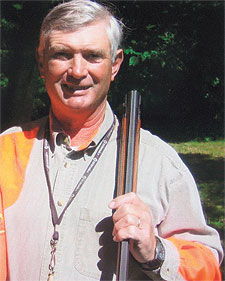By James B. Spencer
 Gary Wilson |
"For the average hunter," Gary said, "the most important command is Come. The spaniel that doesn't come when called will tend to self-hunt and flush birds out of gun range."
Gary pointed out that a hunting spaniel need not be steady to flush, but must obey Come, especially in several critical situations. For example, if your spaniel flushes a bird and you miss it, if you can't stop him from chasing it, he will sometimes flush other birds out of gun range. Similarly, if he starts trailing a deer, you need a reliable way of bringing him back into the game you want him to play. Or if he goes into a field in which you don't have permission to hunt, you have to be able to call him back to you.
Then, too, many spaniels don't want to quit hunting at the end of the field or the end of the day. This can be a real aggravation. Even around home, prompt obedience to the Come command can be the difference between a pleasant fireside buddy and a rowdy ruler of the roost.
"You should teach your puppy to come," he said, "as early as possible, using treats plus lots of praise and petting. I encourage our puppy buyers to enroll in a formal obedience class, so the owner and puppy can learn obedience training together."
Gary stressed that, as your puppy matures, he will begin challenging your authority when you give the Come command. Then you need to reinforce that command effectively and thereby reinforce your position as "leader of the pack." If you let him get away with disobedience, even sometimes, he will start challenging your authority across the board, becoming an outlaw instead of an enjoyable hunting partner.
"Whenever he ignores your Come command," Gary said, "above all, don't keep repeating it. Instead, correct him as necessary. If you're young and energetic, run him down, discipline him, and enforce compliance with tugs on a short lead. The less athletic should have the pup drag a 50-foot check-cord until he's completely reliable on the Come command."
Gary pointed out that the modern e-collar, properly used, gives a person perfect control of his dog at any distance. He feels, however, that inexperienced owners should seek professional assistance in learning how to use the e-collar.
| The Most Important Command | 

Don't miss tips for your pointer, here, or your retriever, here.
|
|
"Most e-collars have a warning tone," he said. "After the initial training, most dogs can be handled quite effectively with just that sound, without any further electronic stimulation, or at least with only infrequent stimulations. This makes the e-collar a very gentle correction device."
Gary feels that the most common mistake inexperienced owners make is not reinforcing the Come command consistently. If the dog disobeys, they repeat the command again and again until either the dog obeys or the owner gets really upset and perhaps over-corrects.
Instead, the owner should correct the dog after the initial disobedience in some consistent manner, whether by running him down, by using a check-cord, or with the e-collar. Once the dog knows that he has only one chance to comply with the Come command, he will cease testing the boss.
Gary's final thought was: "Above all, be consistent. Daily obedience lessons on a lead will go a long ways toward making your next hunting season both successful and enjoyable. If you train your spaniel well, and consistently, both of you will have more fun when hunting."
This tip is from Gary Wilson of Sunrise Kennels, 6600 County Route 69, Canisteo, NY 14823; (607) 776-7349; website www.sunriseess.com; e-mail gary@sunrise.com. Gary has been training professionally for 30 years. He specializes in training spaniels for hunting, hunting tests, and field trials, but also trains all sporting breeds for hunting. He participates in spaniel field trials and hunting tests. He judges spaniel field trials and has judged five National Championship Trials.






